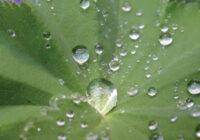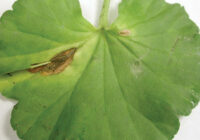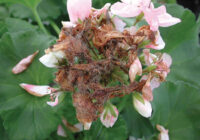
Features
Battling blight
Managing two major greenhouse fungal diseases by manipulating climate: Botrytis grey mold and powdery mildew
February 9, 2024 By Dr. Mohyuddin Mirza
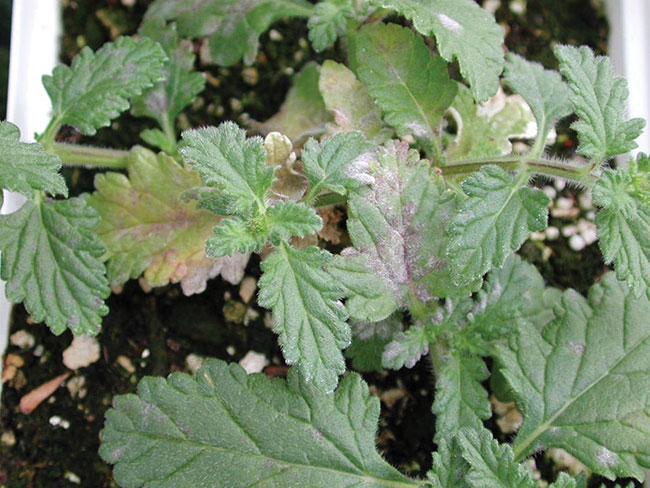 Verbena plants are particularly sensitive to powdery mildew.
Photos: Mohyuddin Mirza
Verbena plants are particularly sensitive to powdery mildew.
Photos: Mohyuddin Mirza There are many strategies to control fungal diseases in greenhouses including use of registered chemicals, pesticides and other products. There are many biocontrol agents available that can be used in the root zone. Many fungal diseases can be controlled by paying attention to climate strategies.
Understanding climate in a greenhouse
So, what factors make up the climate?
- Light, CO2 and water: Light, of course, is the first fundamental input where the energy is fixed from the photons provided through the process of photosynthesis. The reaction involves carbon dioxide absorbed from the surrounding air and water molecule is split and the end result is the glucose which is converted to carbohydrates and stored in cells for later on use in different metabolic processes. Plant health depends on how much food plant can manufacture and utilize for roots, shoots, leaf and flower development and subsequent growth.
- Temperature: It is the starting point for climate control and its application at appropriate times is critical. For example, for each crop there are recommendations for daytime, nighttime, pre-dawn, pre night, daytime average, and 24-hour average temperatures. Then there is temperature ramping from day-to-night and night-to-day and this is the most important aspect of controlling the development of fungal diseases.
- Relative humidity: This goes hand-in-hand with the temperature. This is because the ability of air to hold moisture depends on the temperature of the air. Warmer air holds more moisture while cooler air holds less moisture and that is where condensation comes in.
Growers monitor almost all climate related data on a minute-by-minute basis. Light is logged in Joules and watts, temperature, venting percentage, relative humidity, irrigation volumes and one of the most important data on Vapor Pressure Deficit or Moisture Deficit. By monitoring the data in a graphic form (like in the above image) one can see the relationships between light and temperature, temperature and relative humidity and thus watch for any situations where dew point may be reached. If relative humidity is above 85 per cent then dew point can be reached and condensation can occur on plants surfaces and lead to development and growth of Botrytis grey mold.
Condensation takes place when the air cannot hold on to the moisture and deposits it on cooler surfaces, maybe it is the greenhouse roof or leaves or fruit. Condensation is the root cause of the fungal disease spread and germination of spores.
The amount of water that condenses depends on the humidity, the greenhouse air temperature and the temperature of the plastic roof. Calculations using a computer model show that every year 100 litres of water per square metre condense against the greenhouse roof. The greenhouse ventilation and dehumidification system are designed to get rid of this amount of water and set points on computer help to achieve this.
Grey mold
This fungus is considered “ubiquitous” meaning they are present every where and once settled down on plants parts, need water droplets to germinate and start the process of infection. It is considered a weak pathogen and needs an injury or damaged or decaying parts of plants to start infection.
In image 1, on page 14, one can see how water droplets were sitting on the geranium leaf. In image 2, spores have started germinating and infecting the leaf. In this case the grower was watering late in the afternoon and water did not evaporate. Image 3, above, is from the same greenhouse where not enough attention was paid to adequate ventilation and water droplets were able to condense on the flowers. These pictures emphasize the importance of moisture management and air movement. Any fungicide sprays would not have worked at this stage. Climate control strategies would include:
- Manage temperature in such a way that dew point is not reached
- Temperature ramping from night to day should be gradual. One degree centigrade per hour.
- Dehumidify by ventilation based on relative humidity set points. If outdoor temperature is low, then heat and ventilate at the same time.
- Look for early warning signs of botrytis infection as spotting on leaves.
- Watch for any signs of moisture condensation on leaves and fruits. Tomato fruit may show condensation before it appears on leaves.
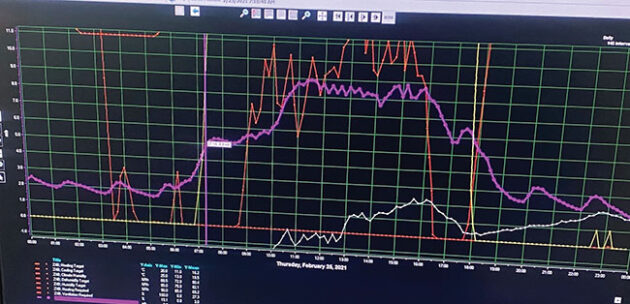
A computer screen showing greenhouse climatic data.
Powdery mildew
Since bedding plants season is coming up, it should be noted that verbena plants (pictured above) are very sensitive to this fungus. Petunias, begonias and rosemary also show symptoms very quickly.
This fungus can also be controlled and prevented by environmental management. This fungus has two stages of growth and development. For germination of spores, it requires free water sitting on the leaves or stems and drier humidity to produce white spores. I have seen devastation of crops when plants are grown at a relative humidity of around 50 per cent. This is practiced by growers who are afraid of high humidities. This is also called a disease of over ventilation. Climate control measures include:
- Grow crops at a relative humidity of between 60 to 75 per cent
- Like Botrytis grey mold, avoid condensation by temperature ramping and watching dew points
- Silicon use as part of nutrients management is helpful
- Having knowledge of integration of climate factors can help to avoid these two and other diseases as well for better sustainability.
Dr. Mohyuddin Mirza is a greenhouse industry consultant based out of Alberta.
drmirzaconsultants@gmail.com
Print this page
